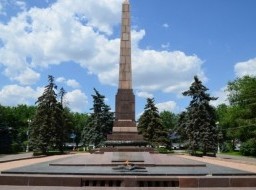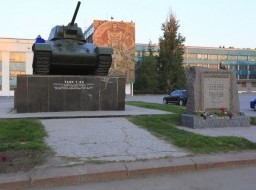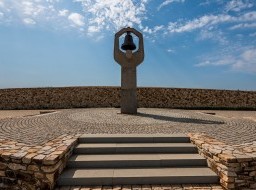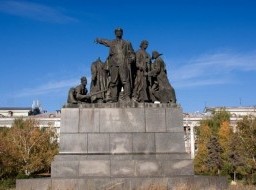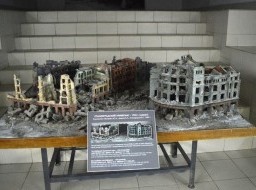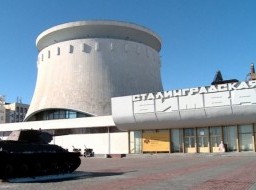Panoramic museum The Battle of Stalingrad
This enormous museum has eight large display rooms filled with exhibits on WWII and the Battle of Stalingrad. There's little English signage but each room has a short synopsis in English on the room's particular theme. Audio headphones are available for a fee. A highlight is the vivid 360-degree Battle of Stalingrad Panorama. The museum is close to the Volga River, several blocks north of alleya Geroyev. The entrance is located at street level on the side of the building facing the Volga. The area around the museum has some pretty views out over the river and plenty of old tanks and planes for kids to climb around on. Next to the museum stands the remains of an old mill, dating from 1903, that was destroyed in the battle. It's left standing as a reminder of the horrific fighting. Volgograd State Panoramic Museum “The Battle of Stalingrad” has lead its life from the Museum of Defense of Tsaritsyn named after Stalin, and it was opened on the 3rd of January of 1937. In 1948 it was renamed in Museum of Defense of Tsaritsyn-Stalingrad, in 1963-1982 it became Volgograd State Defense Museum, and in 31 of May of 1982 it turned out to be Volgograd State Panoramic Museum “Stalingrad Battle”. The composition of museum consists of 2 sights:
Since 1989 the museum has opened a constantly fulfilling exhibition of Afaganistan Hall. It exposes documents, honors and private possessions of the participants of the war actions in Afaganistan and Chechnya, modern weapons and war machines. Unique collections and museum exhibits were demonstrated at the exhibitions in England, France, Germany, Austria, Luxemburg, Czech Republic, Poland and Bulgaria. Since the 1937 the museum has been visited by more than 30 million people, including 16 million which has visited it during the period of work of panoramic museum “Stalingrad Battle”. Nowadays the museum and its branches are visited by more than 500 thousand people yearly. Complex of panoramic museum “The Battle of Stalingrad” was created on the basis of the project of Volgograd architects under the guidance of the public architect of USSR V.Malyaev. Panorama “Defeat of the Fascists Armies at Stalingrad” happens to be one of the major monumental memorials of the city of Volgograd. Creation of panorama became possible owing to the hard work of seven painters of Moscow M. Grekov Studio of Battle Painting, M. Samsonov (art manager of the group), N. Bout, V. Dmitrievsky, P.Zhigmont, P. Malzev, G. Marchenko, F. Usipenko. Certainly panorama isn’t only a historic memorial to the events of the Stalingrad battle, which are depicted on the canvas. Doubtlessly, this is a cultural monument and a work of art all in one. It also comes to be the reflection of the views, the tastes and the ideology of the times when it was established ( four decades had passed from the moment of the appearance of the idea about the panorama up to the moment of its construction and opening on the 8th of July 1982.). The panorama absorbed all the merits and demerits of a huge historical epoch. This time period is a good aid in objective appreciation of it. The viewer is shown a grand panorama of the battle of 26th of January1943. One can see the familiar silhouettes – the windmill, Pavlov House, 9th of January Square, water pump tower of the railway station “Stailngrad-1”, grain elevator, “Red October”, “Lazur” and “Tchermet” plants. A significant part of artists’ attention is paid to the battle-grounds and topography, interaction of different military branches of aviation and ground divisions – infantry, tanks, and artillery. In spite of all these facts, the panoramic canvas can’t be called a precise historical illustration. Grekov’s artists have recreated the heroic spirit of those times, made up the image of the ruined but victorious Stalingrad and established the united spirit of fortitude. In order to reach the named above impressions, they have used the effect of combining in the time and space, which is well-known and widely practiced in easel painting and panoramic works. Against the background of the military operations, the artists are resurrecting the legendary heroic deeds of Stalingrad Battle – a signalman Matvei Putilov, who connected the ends of the torn wires in his mouth, a junior sergeant Nicholai Serdukov, who covered the embrasure of the enemy’s gun with his chest, a pilot Viktor Rogalsky, who performed an air-ground ram attack, a nurse Anna Beschastnova, who saved the lives of thousands wounded soldiers by carrying them out of the battlefield, a Red Army soldier Mikhail Panikakha, who jumped at the enemy’s tank and caught himself on fire. This way, through the certain heroic deeds the authors narrate about the great exploits of the dead and the living, about the enormous prize of the victory. The exhibition of the panoramic museum “The Battle of Stalingrad” was opened on the 6th of May 1985 in honor of the 40th anniversary of the Victory over the fascists Germany. In the halls of the museum there are around 4 thousand exhibits exposing the history of the Stalingrad battle: photographs, documents, honors, armors, private possessions of the soldiers defending the city and glorified military commanders. Exposition has been arranged by the scientific staff team of the museum. The consultants, whose advice was used in the process, are the specialists of the Institute of War History. The decoration of the Halls was performed with the assistance of the painters from Leningrad Decorative Works Complex (artist studio of V.Revin). |

